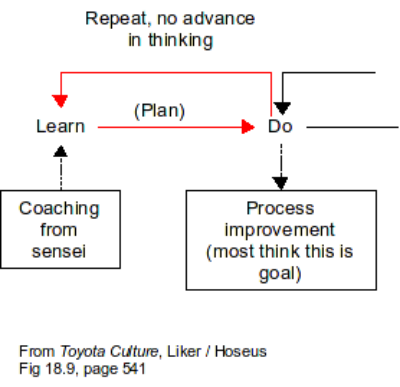A couple of days ago I had an interesting session with an improvement team in a fairly large company. They have been working on this for almost 10 years, and believe that while they have made some spot progress, they are clear that they have spent a lot of money but not yet established what they call a “lean culture.” Their implied question was “How do we get there?”
My question was “When you say ‘a lean culture,’ exactly what are you thinking about?”
What do people do? How do they behave?
“People find and eliminate waste every day.”
OK, so if they were doing that, what would you see if you watched?
There was a bit of a struggle to articulate an answer.
I see this all of the time. We rely on the jargon or general statements to define the objective, without really digging down the next couple of layers and getting clear with ourselves about what the jargon means to us. This is especially the case when we are talking about the people side of the system.
But the people are the system. They are the ones who are in there every single day making it all happen. It is people who do all of the thinking.
Consider these steps:
- Define Value.
- Map your value streams.
- Establish flow.
- Pull the value through the value stream.
- Seek perfection.
This is the implementation sequence from Lean Thinking by Womack, Jones and Roos, that has been the guideline for a generation+ of practitioners.
Learning to See taught that generation (and is teaching this one) to establish a current-state map of the value stream, and then a design the future state to implement as flow is established. The follow-on workbooks focused on establishing flow and pull, and did it very well.
While not the only way to go about this, it does work for most processes to establish flow in materials and information.
But what do people do every day to drive continuous improvement, and how are those efforts organized, harnessed, and captured to put the results where they can truly benefit customers and the business?
Here are some things to think about.
What exactly is the target condition for your organization? Can you describe what it will look like? Can you describe it in terms of what people experience, and do, every day?
When your people go home to their families and share what they did at work today, what will they talk about? And I don’t just mean the engineers and managers. What will the front-line value-creating people remember from the workday?
How will they talk about problems?
If your target future state now includes changes in how people work, ask yourself more questions.
When, exactly, are they going to do these things you described? By “when” I mean what time, starting when, ending when.
What, exactly, do they do when they encounter a problem during production?
How, exactly, do you expect the organization to respond to that problem? Who, exactly, is responsible to work through the issue and get things back on track? How long do they have to do it? If the problem is outside their scope, what is supposed to happen? How, exactly, does additional support get involved?
If these new activities involve new skills, when and how, exactly, are people supposed to learn them and practice them to get better at it? Who is supposed to teach them, when, where, and how? How will you verify that the new skills are being used, and are having the effect you intend?
“If we do this, what will happen?”
And then what? And then what?
Think it through.
The “people” future state is far more important than future state of the material and information flow.




